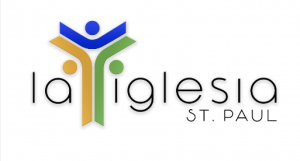WHAT OUR LOGO REPRESENTS

The logo represents three people, because the church is the people of God, not buildings, chairs or a steeple. The three people come together and when they do they form the cross of Christ, the symbol of Christianity. The dot or circle represents the person’s head and the colored lines represent the arms and therefore the action of the person. The person in blue represents a person in adoration or worship. The person is lifting up his arms toward heaven in worship. The blue color represents heaven where God resides and where all of our worship is directed to. The person in green, a color associated with life, growth and reproduction, means missions. It is the mission of Jesus to go into the world to share the Gospel of Jesus Christ and to make disciples, that make disciples. The result of that will be life, growth and multiplication. As the church fulfills the mission there will be more people saved and transformed. More disciples of Jesus. And more churches. There will be growth and multiplication. And the person in yellow, which is a warm color, signifies the close relationship among brothers and sisters in Christ who gather together to edify one another:
- by teaching one another,
- or by using their spiritual gifts and natural talents,
- or by encouraging one another by praying and caring for one another.
Our name is simply La Iglesia (the church) because that’s exactly what we were called to be and what we want to be. We simply want to do what the church is supposed to do (Adoration, Edification and Mission). And just as the original church did not have a name such as Trinity Church, or The Good Shepherd Church or Harvest Bible Church, we prefer to call ourselves La Iglesia to express not only what we want to be and to do, but also to express our simplicity. We do not want to be a sophisticated, complex or fancy church but a simple church like the church in the book of Acts. And just as the first church was recognized by its location (the church in Rome, the church in Ephesus, the church in Corinth, etc.) we want to be identified as the church in our different locations. We are the church in Saint Paul.
